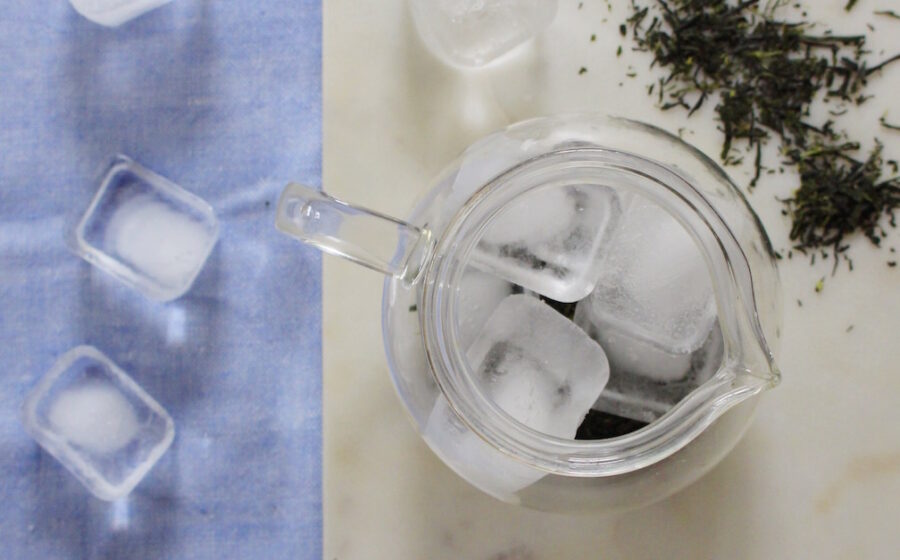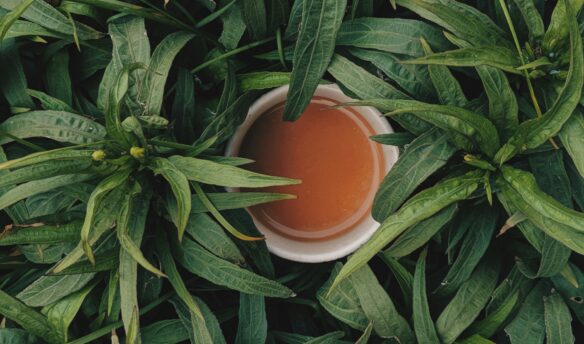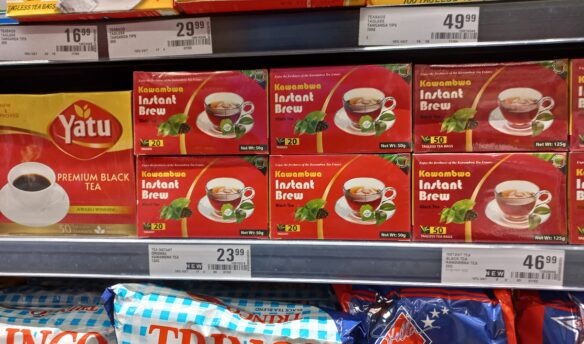[T]hreaded throughout the Japanese tea ceremony are lessons in patience and mindfulness. One could apply those principles to the Japanese method of brewing tea with ice, shinobi-cha. Quite the opposite of the speed-obsessed Western iced tea preparation, shinobi-cha requires one to wait hours to savor a small amount of tea. The concept is rather simple: add green tea leaves to a vessel, place ice cubes directly on the leaves, and then allow them to melt naturally to slowly extract the essence of the tea. The final flavor is intense, pure, and sure to be something you’ve never quite tasted before.
While you can choose from an array of Japanese green teas, I would highly recommend practicing the art of shinobi-cha with a gyokuro green tea. A highly prized tea, gyokuro is shaded from the sun prior to being harvested, which increases the amino acid l-theanine. This amino acid intensifies the umami notes and sweet flavors inherent in the leaf. While brewing tea at cool temperatures extracts less caffeine compared to a hot brew, the real reason to experiment with this ice-brewing method is for the flavor. Caffeine and catechins within the leaf produce bitter, astringent flavors. Since caffeine and catechins are less likely to be fully extracted in a cold brew, those flavors are muted in the ice-brewed tea. In comparison, l-theanine can be extracted even at lower temperatures, resulting in a unique sip that draws out the intense umami notes and sweet flavors of the gyokuro.
In order to practice this style of brewing you only need gyokuro tea leaves, a tea vessel, ice, and a strainer. You can absolutely use a pour-over vessel, allowing the ice to melt over the tea and then letting gravity drip the tea through into a second chamber. However, the most traditional method involves adding tea leaves to a kyusu Japanese tea pot and filling the remainder of the pot with ice, allowing it to melt and mingle within the pot (note that you want to keep the pot uncovered). A kyusu teapot is often recommended because there is a strainer built into the vessel and it is most often made with clay (a material that helps to mellow the tea). While some tea connoisseurs believe a glass vessel may negatively alter the taste, feel free to experiment with a variety of pots to see what flavor outcomes suit you (note that a glass teapot was used in featured photographs to offer the best visuals throughout the ice brew process).
Before you add the leaves to your teapot, consider the ice. Good water is the best foundation for a cup of tea, and since this method of brewing aims to highlight intensely pure flavors it’s best to use spring or filtered water when making your ice cubes. In terms of a tea-to-ice ratio, this practice is truly personal. While some resources recommended using seven to eight grams (approximately 1.5 tablespoons) of gyokuro, then filling the kyusu with ice, I opted for ten grams (a little over 1.5 tablespoons) and six ice cubes, to extract a more intense flavor. I would recommend filling two to three kyusu pots or other teaware vessels with varying gram weights of gyokuro to discover one that excites your taste buds.
A highly prized tea, gyokuro is shaded from the sun prior to being harvested, which increases the amino acid, l-theanine.
Once the ice cubes have been placed over the tea leaves, allow them to completely melt before straining the liquor from the leaves. This melting process can often last hours, depending on the strength of sunlight from your window or ambient temperature, and will require patience. Relish in the slow process, and consider that each ice brew may vary depending on the weather beyond your windows and around your table. In essence, each brew will reveal unique nuances depending on your environment on that particular day. While some have noted that they enjoy taking small sips throughout the melting process, I recommend abstaining until the very end for the most intense and developed taste.

Your patience will be rewarded as you slowly savor each robust, rich drink of ice-brewed gyokuro. Truly refreshing in temperature and taste, this method of brewing highlights the umami flavors at first taste and makes us quite aware of the absence (or muting) of the bold astringent flavors often associated with Japanese green teas. Following the savory umami notes that send my mind to a delicate salt, you’ll taste pleasant vegetal nuances that recall tastes of cooked spring asparagus or blanched spinach. Several drinks in, the sweetness (similar to sugar cane) will build and linger on your palate. Shinobi-cha not only extracts a pure, smooth essence of the tea and presents it to us in a bold way, but it also reminds us to enjoy slowly and thoroughly.
—Alexis Siemons is a tea consultant a writer. She blogs at teaspoonsandpetals.com.



















